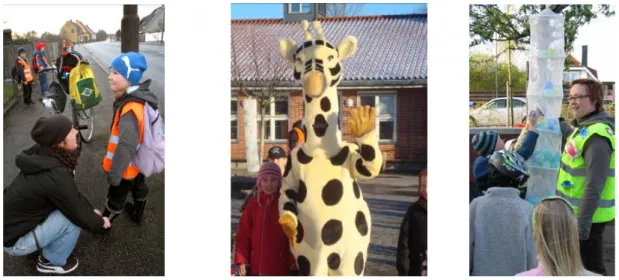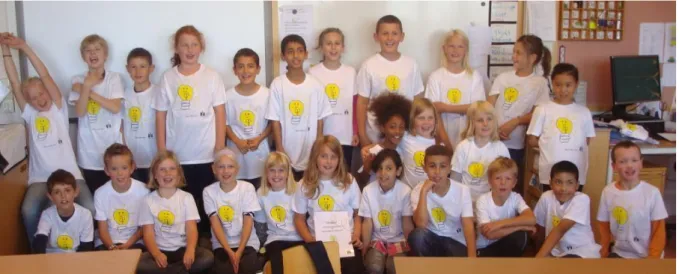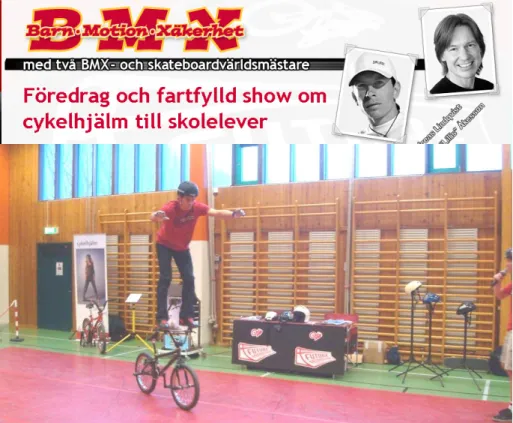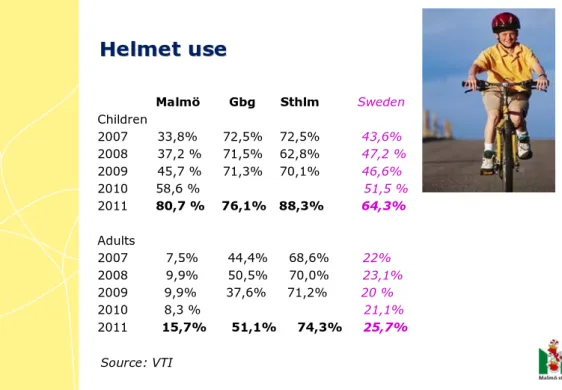16th Road Safety on Four Continents Conference Beijing, China 15-17 May 2013
ROAD SAFETY SCHOOL – HOW WE WORK WITH SCHOOLS AND
TRAFFIC IN MALMÖ, SWEDEN
Lotta Cederfeldt Street and Parks Department
August Palms plats 1 SE-205 80 Malmö, Sweden
+46 40 34 21 48
E-mail: lotta.cederfeldt@malmo.se
ABSTRACT
Traffic is constantly around us, that is why we must help our children to relate to traffic. We can do so by providing them with the right tools to use in different situations. If our children get Transport Training (together with adults) they will learn how to react in traffic. Then children will become more independent and will be able to get to and from various destinations, without being dependent on their parents.
It is very important to help parents understand that they are a part of the issue too, when it comes to road safety. A child doesn´t act like it´s told to, it acts like you do. All adults need to be good role models. If we can accomplish that, it would be a lot easier for our children in traffic.
Since the 1990’s, the Streets and Parks Department in Malmö has been supporting local schools with their road safety education. The site www.malmo.se/trafiksakraskolan (Road Safety School) offers activities, courses and competitions. The Department has also developed materials for all grades from pre-school through to high school. The materials are continuously updated. Schools can also borrow other materials and/or participate in activities that can be implemented into theme days. Teacher's guidance at staff meetings is also offered.
Among other things, reflectors are distributed to all children in the first four grades. There are also school projects which inspire children to walk or cycle to school by cooperating with the schools. Additionally we are providing information to parents and organizing fun activities for the children.
Everything offered is free for schools in Malmö.
Many other municipalities in Sweden are using all or parts of Malmö's material. In the Swedish curriculum plan from 201,1 traffic is now included.
A survey conducted by the Streets and Parks Department, shows that teachers work with road safety education in various ways. They are pleased with both the initiatives from the Street and Parks Departments and also the provided materials. They see it as an educational tool and find it useful even though it is not used in the same way. Teachers know that students like the materials and the received feedback from parents is positive.
Now the Streets and Parks Department has got a new challenge. The schools are asking for more support when it comes to meetings for parents, theme days and so on. It seems like the positive cooperation has developed a larger interest for traffic and road safety in the schools. If so, then we are on the right track.
In the presentation I will show the materials, the activities and competitions that are offered to the schools in Malmö.
1 BACKGROUND
The increasing car traffic is limiting the possibilities for children to play and explore the surrounding neighbourhoods. Parents are afraid that something might happen to their children, therefore they drive them everywhere. The natural exercise is removed when children are taken to school or other activities by car, Regular exercise is one of the most important factors for building bone strength. Those who exercise at young ages build a stronger skeleton with a higher BMD (Bone Mineral Density). Additionally, children who exercise on a daily basis are able to concentrate for longer and are more alert. Research shows that there is a clear connection between physical activity and performance in school, and walking or cycling to school contributes towards this.
That is why we need to help children and parents so they can be responsible road users. However, adults must never forget that children are vulnerable in traffic and are influenced by adult behaviour. Adults must always take responsibility for children’s safety in traffic. To do that, we must ask the following questions: How do we behave in traffic? How are our attitudes as road users?
We have to work with, investigate and discuss traffic in school, where we meet children of all ages and their parents. That is why, since the 1990’s, the Street and Parks Department in Malmö has been working to support local schools with their road safety education. The web site www.malmo.se/trafiksakraskolan offers activities, trainings and competitions. The Street and Parks Department has also developed free materials for all grade levels from kindergarten through to high school. The material is continuously updated. The schools are offered activities and materials to implement theme days as well as teacher's courses at staff meetings. Every year reflectors are distributed to children in the F-3 classes. School projects to reduce traffic around schools that involve children and parents are ongoing.
From 2011 in the curriculum LGR 11 for all Swedish schools, traffic is included as a knowledge requirement for grade 3.
The Street and Parks Department has evaluated its work with the schools and the results will be presented after the description of materials and activities.
2 DESCRIPTION
The aim of our work in school is to:
• Help teachers integrate traffic, environment and sustainable development in their teaching.
• Make pupils (and their parents) become more aware of traffic, environmental and health issues, as big danger for our children´s lives and health.
3 ACTIVITIES AND MATERIALS
3.1 Material for Preschool
Play, Explore, Learn: More than a hundred pre schools have worked with this project since 1995. Many of them continue to work with traffic every year. In 2010, 25 pre schools were involved.
16th Road Safety on Four Continents Conference Beijing, China 15-17 May 2013
Figure 1: Materials for pre schools
3.2 Material for Compulsory School
The Traffic Animals and the little alien Gnorpan, are characters who help the children aged 6-9 in traffic. The book Trafiksäkra skolan (Road Safety School) is for the children aged 10-12 years.
Figure 2: Traffic Animals, What’s traffic? said Gnorpan, Road Safety School
Included with the books is a teacher’s guide. Issues highlighted in these books include; what’s traffic, walking, cycling, visibility when it is dark and how we all should behave in traffic. A new board game about traffic is also developed for the target group aged 10-12.
Materials for students aged 13-16 are also available.
The materials from Malmö are frequently used by many municipalities in Sweden.
3.3 Friendly Way to School
Friendly Way to School was a project devised to find a way of inspiring children and parents to walk or cycle to school. By cooperating with schools, providing information to parents and organizing fun activities for the children, the results point in the right direction.
In the school year 2009-2010, 2700 pupils from 15 different schools participated. The percentage share of children being driven to school was reduced from 75% to approximately
50%. The statistics from 2012 show this figure has now dropped down to 45%. Parents were asked two questions after one year:
Do you think more about what the problems driving to school might cause? Results show that 60-65 % said yes.
Have your children’s mode of transportation changed towards a more environmentally friendly way? The response was 46-49% said yes. Friendly way to school is now a permanent effort where you can meet the Traffic mascot: Lotta the giraffe.
Figure 3: Activities in Friendly way to school with Lotta the giraffe
3.4 Education on the Internet
100 primary and secondary schools receive a newsletter by email with information and activities on offer every term. The newsletter can also be downloaded
from malmo.se/trafiksakraskolan. On this website you can read about activities, offers for schools, education for teachers and competitions. You can also find a link
to trafiksakraskolan.se where interactive web sites are situated: A day in the Traffic jungle, Traffic Rules and ADT (Alcohol, Drugs, Traffic).
In the Traffic jungle you can meet some of the traffic animals again who will guide you through some difficulties.
In Traffic Rules, you can watch three movies, play a memory game or participate in a quiz. ADT looks like a bill board where you can read notes and cards which are all related to ADT. New materials are soon to be found on trafikifokus.se (discussion and valuation exercises).
3.5 Competitions
Every year all children aged between 6 and 10 are invited to participate in the competition Design the reflector of the year. Approximately 1000 drawings are sent in and one of them is printed on reflectors and later distributed to all 6 to10-year olds in Malmö.
16th Road Safety on Four Continents Conference Beijing, China 15-17 May 2013
Figure 4: The winners 2011
3.5.1 Thumbs up for climate smart kids!
A two week long competition beginning in Mobility Week encouraged 3200 children to not take the car to school. Together they walked, cycled and caught the bus, travelling the distance of 36,350 km, which is almost one lap around the world. Even though it was a competition, everybody could win. All the participants were invited to a show with two World Champions in BMX and skateboard. Except from stunts and tricks, the show was also a disguised lecture about the importance of wearing helmets.
Figure 5: The BMX show
Advertise helmet use (adults included). The children were asked to make an advertisement describing that you should were a helmet when you are cycling. The winning drawings were put up on billboards all over Malmö.
16th Road Safety on Four Continents Conference Beijing, China 15-17 May 2013
Figure 6: Winning posters
3.6 Helmet Use
As part of our research, we interviewed teachers to gain an understanding of who influences children’s behaviour concerning traffic conditions. The majority of teachers who were interviewed, responded saying both teachers and parents are great role models for children. Additionally, it is also mentioned that many of them are not always good role models in traffic. Many teachers and parents do not use helmets themselves when they ride their bikes and the kids can be influenced by this. It is therefore important that the Streets and Parks Department continues to inform teachers and parents about the importance of being a good role model in traffic.
The Streets and Parks Department take part of the yearly helmet inventory conducted by the National Road and Transport Research VTI. It shows that during the years we have been working with helmet issues – for instance the Ambulance tour and the competitions – the helmet use among both children and adults, has increased. The city of Malmö has worked with neighbour cities and the Swedish Transport Administration for several years to increase the use of helmets. We carried out a couple of campaigns and handed out helmets to teachers and parents so that they could continue to be a good role model.
A bike helmet can be used for many things Find a good way, you too!
You´ve only got one head - use it!
Figure 7: Figures showing helmet use in Sweden 2007-2011 (Source: VTI 2012)
3.7 Visit from a Bus
A bus and the driver visits the schools and the children can learn about safety on a bus, buying tickets, time tables and sometimes vandalism.
3.8 Ambulance Tour
To help the teachers with certain matters, they are offered different activities. For the children aged 11-13 who are supposed to wear bike helmets but do not always do so, there is the so called Ambulance Tour. The class is visited by an Ambulance Driver/Nurse who tells the children about real life cases and what can happen if you are unlucky.
3.9 Road Safety for Grade 8
Educational runway/Bulltofta Day: Students at the age of 14 are offered a day in practical and theoretical exercises that regards traffic. The exercises they test during the day are: braking distance, belt use, visibility from and turn with bus/truck, bicycle knowledge, test of car crash impact scale and a car that rolls over.
Helmet
Helmet
use
use
Malmö Gbg Sthlm Sweden Children 2007 33,8% 72,5% 72,5% 43,6% 2008 37,2 % 71,5% 62,8% 47,2 % 2009 45,7 % 71,3% 70,1% 46,6% 2010 58,6 % 51,5 % 2011 80,7 % 76,1% 88,3% 64,3% Adults 2007 7,5% 44,4% 68,6% 22% 2008 9,9% 50,5% 70,0% 23,1% 2009 9,9% 37,6% 71,2% 20 % 2010 8,3 % 21,1% 2011 15,7% 51,1% 74,3% 25,7% Source: VTI
16th Road Safety on Four Continents Conference Beijing, China 15-17 May 2013
Figure 8: Activities Bulltofta Days
Additional Information
Teachers are offered education every term.
The schools can borrow a laser radar gun to measure speed. They can also borrow a big memory game for outdoor use.
The traffic mascot Lotta the Giraffe visits schools to help them with Friendly Way to School. Smaller children are offered a Christmas calendar with a traffic theme.
4 RESULTS OF EVALUATION
4.1 Intentions
Since the 1990’s, the Streets and Parks Department in Malmö has been supporting local schools with their road safety education. The purpose of the study was to gain a deeper understanding of the schools' needs when it comes to working with traffic.
4.2 Method
The study was divided into two parts: interviews and a web survey.
The target group for the evaluation were teachers from approximately 100 F-9 schools in Malmö and the study began with eight telephone interviews with teachers. They were followed by a web survey with 1069 complete sheets. The survey was conducted from May 25 to June 7 2011 by Ipsos Public Affairs.
4.3 Interviews
Ipsos conducted eight personal telephone interviews which lasted approximately an hour. In depth interviews allow the interviewee to gain a deeper understanding about their own attitudes, experiences and expectations without the need to be influenced by others. In order not to lose the opportunity to recall and discuss the material, the telephone interviews happened in connection with an internet connected computer. Ipsos could relate to the interview send over documents with pictures and examples of materials, to remind and thus get input on how materials and activities were actually perceived by the teachers.
For the purposes of this study the Streets and Parks Department wanted reconcile issues such as:
How do you work today with traffic education in school? -How has this changed over the last few years?
- What new needs do you see in the future? What type of materials do you work with today? - In what situations?
- What is this material like?
Knowledge of "Road Safety School"
- In what context have you come in contact with the investment? - How is it?
- What parts do you see included in the venture? (materials, activities, etc.) Knowledge and use of materials related to investment:
- Strengths - Weaknesses
- Potential for development
- Prioritization of material - estimated high / not estimated Knowledge and use of activities related to investment: - Strengths
- Weaknesses
Potential for development
- Prioritization of material - estimated high / not estimated
Commitment - linked to the traffic as a subject in school and to the material - In students
- In teachers - In parents
- What is required to achieve the objectives?
- How can this be linked to the project "Road safety school "? The perception of the Streets and Parks Department´s role.
Other comments on investment, primarily from a development perspective.
4.4 Survey
To validate the results of the qualitative study, a quantitative survey was conducted with teachers in the relevant grades. A quantification facilitates efforts to plan and prioritize the potential actions identified /considered desirable by those teachers who were interviewed. The starting point of the questionnaire in the quantitative study is the qualitative Query Wizard, and the reported results of the qualitative study.
Web Survey (CAWI)
16th Road Safety on Four Continents Conference Beijing, China 15-17 May 2013
1069 were completed.
Data collection for the period May 25th to June 7th 2012.
5 CONCLUSIONS
Teachers work with road safety education in different ways.
The differences are mainly due to the way teachers choose to adapt material to the different grade levels.
In general, in the younger grades, traffic education is more "practical" overall in comparison to the older grades.
The teachers who teach in grades P-4 said that traffic education is something they conduct every time they go out with the children. They discuss pedestrian crossings, how to cross the road and how to ride their bike safely. For the older grades, especially grade 8, the teachers
talk mainly about "Bulltofta Day". They mentioned it as an excellent activity to engage students and to give them a more concrete reality of the risks involved with traffic. In the older grades, traffic education occurs in planned periods and tends to be concentrated around the times when schools have theme days / theme weeks.
In general teachers ask for more help to teach children about traffic. Lack of time and personnel is a problem and being able to "hire" help with traffic education would be appreciated.
Generally, teachers in Malmö are very satisfied with the support they receive from the Streets and Parks Department. The materials used in teaching and in various traffic activities are highly appreciated in general. The teachers find the communication with the Streets and Parks Department easy and satisfying. Although the materials and activities that the Streets and Parks Department offers are appreciated very much, the teachers are having trouble keeping up with everything. Several teachers are asking for the possibility to "borrow staff" who can assist with theme days, theme weeks and so on. Authority figures such as the police create a big impression on the kids. When children get information about traffic from multiple sources at the same time, it provides a great combination effect that reinforces the message. The interactive material on the internet is not used as much as the printed material. One reason is said to be the lack of computers in schools. More information about the interactive material is needed as many teachers didn´t know about it. The teachers would like more information about practical details concerning the area around the school, such as which to contact if you have remarks on roads, road works, signage, etc. The majority of people interviewed said that teachers and parents are great role models for children. However, many say they are not always good role models in traffic conditions. Many do not use helmets themselves when they cycle and the kids can be influenced by this. The Streets and Parks Department will continue to inform teachers and parents about the importance of being a good role model in traffic.
Throughout, teachers were satisfied or very satisfied with the materials and activities that the Streets and Parks Department provided. Teachers also feel that students have a positive attitude to the material and received feedback from parents was also positive. Some uncertainty exists as to whether the materials and the activities it carries out are from Streets and Parks Department or the schools themselves. The contact with the Streets and Parks
Department is perceived to be very good, especially the close collaboration with Lotta Cederfeldt mentioned by many as very positive.
Just as the qualitative study showed the teachers are positive to both the initiatives and material that the Streets and Parks Department provides. Nearly four in ten four out of ten have taught traffic education, where just over half the materials were from the Streets and Parks Department. Nearly six out of ten know that the Streets and Parks Department provides materials for traffic education. Among the teachers in years 1-6 is the knowledge of the material that is generally higher than in years 7-9. In the younger grades, a greater variety of the materials and activities are available while Bulltofta days are what most teachers use in the grades 7-9. They are happy with the material the Streets and Parks Department provide and see it as a useful tool to support the teaching of traffic education. The most usual comment is that they occasionally use the material. Teachers also feel that students have a positive attitude towards the material and those who got feedback from parents have also received positive comments. When it comes to what can be improved with the material, teachers feel that they need more information and visits from the Streets and Parks Department in the schools.
6 REFLECTIONS AND CONCLUSIONS
The city of Malmö must continue its work with local schools. It is important to help our children to relate to traffic, to encourage transport training and knowledge, and also how to behave in traffic. Daily exercise like walking or cycling to school is important when it comes to concentration and results in school. We can also see that our effort to help with materials and activities is appreciated by the teachers which helps them to keep up the good work.
The teachers are important! They need all the tools they can get to keep up the good work. They need support from others to help teach traffic education as well as the use of materials and activities.
The materials used and activities created must involve the children. The fun parts make it more interesting to continue to learn about traffic.
The children can affect their parents who must understand their importance of being role models. Don´t forget the parents!
You are never finished…there are always new children, new parents and new teachers. Occasionally there comes a new curriculum as well.
REFERENCES
Almgren A (2012) Utvärdering av Trafiksäkra skolan – en kvalitativ utvärdering för
Gatukontoret Malmö stad. Ipsos Public Affairs
Almgren C, Thelin A (2012) Trafiksäkra skolan 2012 – kvantitativ undersökning bland lärare
i Malmö stad, Ipsos Public Affairs
Ericsson I, Karlsson M (2012) Motor skills and school performance in children with daily
physical education in school – a 9-year intervention study, Malmö University
Larsson J (2012) VTI – Cykelhjälmsanvändning i Sverige 1988-2012, resultat från VTI:s






